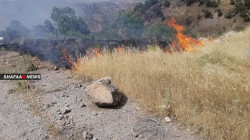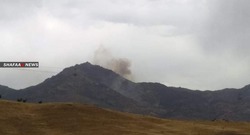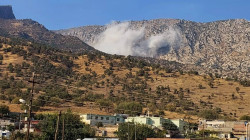Amadiya..A city no longer able to embrace more of its children

Shafaq News/ Mateen mountain in the north, Gara mountain in the south, and countless springs and streams, all gather to illustrate a breathtaking city inhabiting a castle rising 1400 m above sea level. The city is oval-shaped and based on a single rock with a limited area of about 3,600 square meters; and with orchards on all its sides, this mesmerizing city looks like a large stone in the middle of a garden.
Amadiyah, or Amedi, is a castle that has been inhabited since ancient time.. A rock that challenged anyone who tried to force his way into it.
In the north of Duhok governorate, Amadiyah is manifested on a small area of land.. With its history, heritage, and tombs, Amedi immortalizes an important part of the region’s history.
In its center lays a castle with origins dating back to the 8th millennium B.C. -without expanding geographically.
Amedi’s area of 1,000 square kilometers has been recording history for centuries, most splendid of which is the castle’s era –dating back to the reign of Sultan Hussein Al-Wali in the 16th century A.D.; the Sultan was strikingly interested in culture, science, and all aspects of life -according to Dr. Pervan Amedi, a specialist in history at Duhok University.. In Al-Wali’s era, Amadiya became a meeting place for scholars from Islamic countries.
A fortress that resisted the invaders and greedy but is overwhelmed by nature’s cruelty. It is a city that grows smaller and is no longer able to accommodate its new children.
The castle’s people are reluctantly forced to leave their city due to the lack of space.
Hussein Ahmed, a resident of Amadiyah told Shafaq News agency about the suffering of Amadiya’s people, "I was born in Amadiyah and my only concern was that my children would have to leave the castle when they get married. Amedi’s people are breeding outside their city. This has been the castle’s case since the ancient time”.
"I visit the castle from time to time.. I can't stand being out of the castle, but that's the rule of this city and there are a lot of Amedi’s people now living in Duhok and other areas”, Rajab Al-Amadi, who now lives with his wife and children in a rented house outside the castle, told Shafaq News agency.
Archaeologists talked about Amadiyah.. Historian Fareeq Abdul Rahman said that it is the city of Amat mentioned in the Assyrian plates. Perhaps the oldest mention of it was in the news records of The Assyrian King Shamshi-Adad V (823-810) B.C. -contained in the King’s obelisk, found in the southwest Palace of Nimrod and is currently in the British Museum under No. (110) published by the archeologist Lokinel. The city is also mentioned by Assyrian King Adad-Nirari III (805-782) B.C. by the same name in his obelisk which includes His works and conquests - currently in the Istanbul Museum of Antiquities. Amedi had great strategic and economic importance during the Assyrian era, as commercial convoys passed by carrying goods from Arati to Assyrian countries; also the Assyrian armies used to pass through the city and Duhok Strait following their conquests. But the city lacks any trace of the Assyrians other than the statues carved at the door of Mosul and dates back to the Parthian period (1841 B.C.-826 B.C.).
The beautiful city of Amadiya is famous for its archaeological gates, mosques, and shrines of sultans ruled the area in the Emirate of Badinan’s crucible in the 6th century A.D.; and is full of celebrities in the fields of science, art, culture, and education in addition to its picturesque tourist site.. All that did not help Amedi's people to stay in their castle, which has remained steadfast to this day.





